Yves GARY Affichages : 5778
Catégorie : RANGER
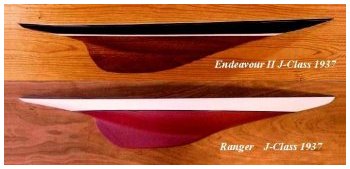
 Ranger, the "Super J"
Ranger, the "Super J"Known as the "Super J", Ranger was designed to the maximum waterline length allowed by the Universal Rule, 87', by a collaboration between Sparkman &Stephens and Starling Burgess in 1937.
Extensive tank testing of numerous hull models, allowed the final decision ...
 ... to be based on which hull would perform best in the expected conditions of the America's Cup off Newport, Rhode Island. Starling W. Burgess was 58 years old when Mike Vanderbilt asked him to join forces with the young rising star of American naval architecture, Olin Stephens, aged 28. Of a common accord, the two men each made drawings, the models of which were tested at Hoboken. The contract binding them stipulated that the name of the architect of the defender chosen was to remain secret, with the merit of the final product being attributed to both of them.
... to be based on which hull would perform best in the expected conditions of the America's Cup off Newport, Rhode Island. Starling W. Burgess was 58 years old when Mike Vanderbilt asked him to join forces with the young rising star of American naval architecture, Olin Stephens, aged 28. Of a common accord, the two men each made drawings, the models of which were tested at Hoboken. The contract binding them stipulated that the name of the architect of the defender chosen was to remain secret, with the merit of the final product being attributed to both of them.
The models were named 77-A, 77-B, 77-C... 77-F "77" was the Sparkman &Stephens' design number. While the models all had 87 foot waterlines, they had different beams, displacements, longitudinal centers of buoyancy, prismatic coefficients and wetted areas. The first tank rests were earned out under the supervision of Kenneth Davidson on the "77" models, but also on those of Weetamoe and Rainbow and notably the excellent 1934 champion, Endeavour.
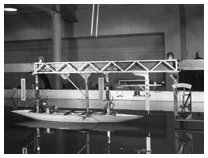 It was the famous model 77 C which was chosen. Burgess and Stephens tried to improve it but in vain - the model was perfect. The choice of the model of Ranger astonished Burgess, without the test results, no one would have dared choose such a design Ranger became part of the legend. Ranger's lines were modified though from the model lines, most noticeably in the bow. The model 77-C did not have the "hooked bow" found on Ranger.
It was the famous model 77 C which was chosen. Burgess and Stephens tried to improve it but in vain - the model was perfect. The choice of the model of Ranger astonished Burgess, without the test results, no one would have dared choose such a design Ranger became part of the legend. Ranger's lines were modified though from the model lines, most noticeably in the bow. The model 77-C did not have the "hooked bow" found on Ranger.
Many people thought for a long time that Ranger could only be the fruit of Olin Stephens' talent. Even Harold S. Vanderbilt was convinced. We must acknowledge Olin Stephens' honesty when be told a journalist in 1956 that the model picked to become Ranger was in fact a William Starling Burgess model.
INSTITUTE REVEALS TANK TEST DETAILSStevens Pamphlet Tells How Hull for the Ranger Was Selected From Models |
|
 Details of tests made with small model hulls of sailing yachts, including Harold S. Vanderbilt's America's Cup defender Ranger, in a specially-built towing tank, were made public yesterday by the Stevens Institute of Technology through its president, Harvey Nathaniel Davis, in a pamphlet entitled “Towing Tanks and Hulls.“ Details of tests made with small model hulls of sailing yachts, including Harold S. Vanderbilt's America's Cup defender Ranger, in a specially-built towing tank, were made public yesterday by the Stevens Institute of Technology through its president, Harvey Nathaniel Davis, in a pamphlet entitled “Towing Tanks and Hulls.“Laboratory experiments with miniature replicas are becoming a vital procedure in yacht designing since the reliability of towing tank tests has been demonstrated. Among other well-known racing and cruising craft subjected to tank tests were Stormy Weather, White Cloud, Seven Seas, Mood, Lulu, Prelude and Gleam. The tank method of testing has been reduced to an exact science in the last few Years. The model hulls not only are drawn along in a vertical position, but are towed with heel and leeway in agitated water under conditions as near as possible to those prevailing when sailing on the wind. W. Starling Burgess and Olin Stephens designer: of the Ranger, made prelimi- nary tests at Stevens of models of Weetamoe, the first Endeavour and Rainbow |
 to check the results against known J Class performance before going ahead with their plans for the 1937 defender. to check the results against known J Class performance before going ahead with their plans for the 1937 defender.Later, five different proposed hull designs for Ranger were tested in the tank before one finally was found to be acceptable. Then only were the designers ready to turn their plans over to the builders. Much of the credit for the development of these methods of testing hull resistance belongs to Professor Kenneth S. M. Davidson, director of the Stevens towing tank. The tank is 100 feet in length and can test heel angles up to 45 per cent and leeway up to 10 per cent. The pamphlet also upholds the economic value of the tank in testing small model hulls of commercial ships, pointing out that four or five three-foot hulls of slightly differing variations can be built and tested at a cost equal to that of trying out the customary twenty-foot models. |
By Autumn 1936, all lines were confirmed and the decision to build had to be taken. With an offer of build at virtual cost price from Bath Ironworks, Maine, and reduced design fees from Sparkman & Stephens, Vanderbilt agreed to proceed.
 Built from high grade steel - flushed rivet plating, RANGER was launched on 11th May 1937.
Built from high grade steel - flushed rivet plating, RANGER was launched on 11th May 1937.
 Probably Ranger’s exceptional performance in winning four straight races was a surprise to everyone including her designers, her skipper and her crew. She was expected to win, but not quite so conclusively. To her designers, her builders, her skipper and her crew we can only offer our sincerest congratulations but we must not forget the many others who helped to produce this great yacht. The sailmakers had an important part to play and it is on their shoulders that much of the responsibility fell. It was their ingenuity in producing unusual headsails that had so much to do with the retaining of the Americas Cup, as the entire series was more of a battle of headsails than anything else.
Probably Ranger’s exceptional performance in winning four straight races was a surprise to everyone including her designers, her skipper and her crew. She was expected to win, but not quite so conclusively. To her designers, her builders, her skipper and her crew we can only offer our sincerest congratulations but we must not forget the many others who helped to produce this great yacht. The sailmakers had an important part to play and it is on their shoulders that much of the responsibility fell. It was their ingenuity in producing unusual headsails that had so much to do with the retaining of the Americas Cup, as the entire series was more of a battle of headsails than anything else.
Before the series, Ranger experimented with an unusual rayon quadrilateral Genoa jib. it was tried out quietly on the far reaches of Narragansett Bay and without too much ostentation in two or three of the races against Yankee and Rainbow. Few knew of the existence of this sail. In at least one of the Cup Races, Ranger carried this sail all the way around the course and it was carried at some time during all four races. It was designed and made by Prescott Wilson who had so much to do with the new sails used this year. Out of twenty-three sails built in 1937 for class J yachts, Wilson made sixteen.
 Another interesting angle is that Ranger's mainsail was made by Ratsey & Lapthorn originally for Enterprise in 1930, used again on Rainbow in 1934 and in all but the last of the 1937 races. This sail was actually used about seventy-eight times and is even now pronounced to be in perfect condition. Those who saw it during the races remarked on its excellence.
Another interesting angle is that Ranger's mainsail was made by Ratsey & Lapthorn originally for Enterprise in 1930, used again on Rainbow in 1934 and in all but the last of the 1937 races. This sail was actually used about seventy-eight times and is even now pronounced to be in perfect condition. Those who saw it during the races remarked on its excellence.
In the first race of the series, Ranger used Yankee’s parachute spinnaker, loaned by Gerard Lambert, who kindly opened up his entire sail locker for the defender. The new 18,000 square footer was only used in the third race.
Probably one of the chief contributing causes for Ranger’s performance lay in the exhaustive model towing experiments conducted at Stevens Institute of Technology. Model towing tests for sailing yachts have been in more or less disrepute in the past but the newer and more scienti?c methods developed at Stevens are of quite a different character and prove de?nitely the performance.
Taking everything into consideration, Ranger and her performance are most remarkable and she is going to continue for a long time to be an exceedingly hard yacht to beat. Should there come another challenge for the Cup, the designers and others are going to be hard put to produce something better and faster.


It is interesting to note that per the Conditions Governing Races for The America’s Cup, New York Yacht Club, 1937 cabin accommodations were required to include the following minimum fittings:
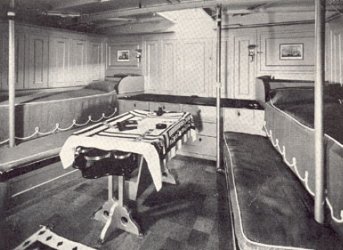 • One double stateroom – with two bunks
• One double stateroom – with two bunks
• Two single staterooms – with one bunk
• Or, four single staterooms
• Each with bureau, hanging locker, seat and individual skylight.
• Two owner’s quarters toilet rooms with toilet, washbasin and door and the usual sea connections.
• Main cabin with skylight and door at the forward end.
• Skylight and hatch for galley and crew’s quarters.
• The main cabin may be used for crew’s quarters.
• Must have an icebox of not less than 45 cubic feet.
• Top of the icebox shall not be below the sole beams.
• Water tank or tanks with minimum capacity of 400 gallons.
• Adequate facility to berth and feed 85% of the paid crew.
Plans publiés sur le blog de Sparkman & Stephens |
|
 |
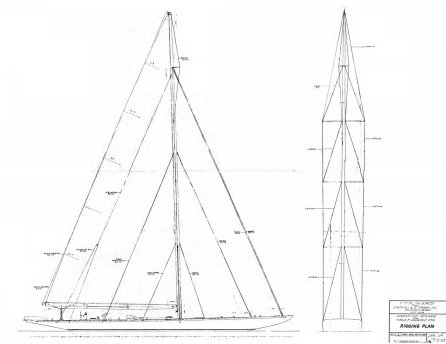 |
 |
|
|
|
|||||||||||||||||||||||||||||||||||||||||||||||
Plan réalisé avec DELFSHIP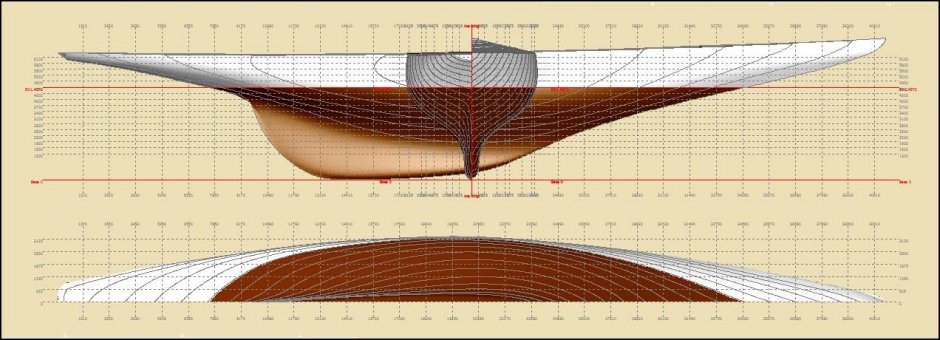

Télécharger les PLANS POUR DELFTSHIP : Coque seule
Télécharger les PLANS POUR DELFTSHIP : Modèle complet


